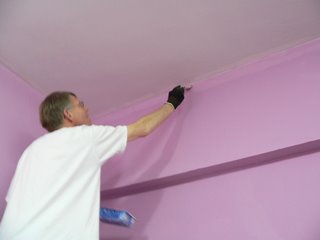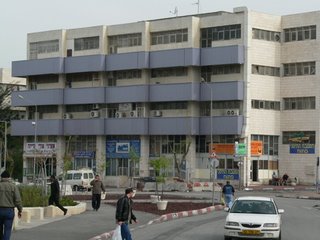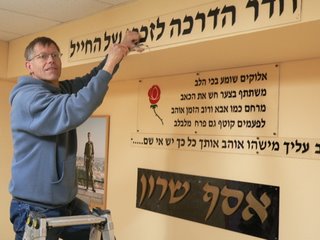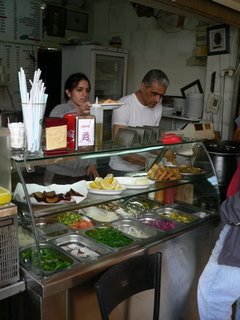




Photos: 1: replacing the remembrance plaques in the “peach” room 2: the falafel stand where we ate lunch this week--delicious! 3-4: painting the “purple” room (yech!) 5: the Bridges For Peace Distribution Center--we have the middle three sections of the lower floors of this building, where you see the blue and white signs over the doorways
------
It was a cold and rainy week here in Jerusalem--and all over Israel! These were “miracle rains” too; it has been a very dry winter and everyone has been concerned about how they will get through the long, hot, dry summer (just like home, after a winter of little snow and rainfall!). Eli, one of the Jewish drivers at BFP, has a small farm and he had us pray in earnest the week before for God to pour out rain even at this late date so agriculture can continue and prosper in Israel. Well, our prayers were answered--and then some! Last Saturday night and Sunday morning, Jerusalem got 112 mm. (over 4 inches) of rain! It poured all night, with thunder and lightning that woke me up. Wadis became raging rivers and washed out roads and everything else in their paths, bringing much-needed water into the Dead Sea. In the plains near Meggido, flooding was so severe that people had to be rescued from roads that had also become rivers, and five people were drowned in the deluge. The Kinneret (Sea of Galilee--the main “reservoir” for Israel) rose 1.5 cm. (about 3/4 of an inch) which was great news for this nation. My apartment was not spared either; two severe leaks brought water into my kitchen, soaked the carpet in my other bedroom, and caused more mildew to form around the window. It continued raining on and off all week too. Fortunately, I was indoors, plastering and painting the whole time.
On Monday, Daniel (the “other” Daniel on the home repair team) and I cleaned up the mess in my apartment, killed the mold and mildew, and repaired and painted the room.
Then on Tuesday, we moved on to the Haberer Youth Center, a Jewish organization for children and teens that provides all kinds of care, educational opportunities, sports, and family help for those living in the area. We spent the rest of the week here, cleaning, plastering, and painting two huge rooms that will be used for the Student Council of the City of Jerusalem and “Tzameret,” a Zionist organization for teens that develops leadership skills through community service projects. Like many of the buildings in Israel, this youth center was not well built. Also, everything in Jerusalem is constructed with stone and cement, making repairs and restoration work really difficult. Daniel and I had our hands full.
But what a delightful place to work! And what a marvelous purpose and opportunity this was for us too, serving such an important neighborhood organization that truly makes a difference in the lives of Jewish young people, many of whom live with a sense of hopelessness and fatalism regarding their future. The center’s administrator, Gilad, was a cheerful, short, friendly young man who always wore his kippah and thanked us continually for what we were doing to help him and the center. Advah and Efrat, two young women who also work at the center, seemed to want to practice their English with Daniel and me. They would come by, comment about the work we were doing, and offer us tea or coffee, cookies, and wanted us to come and sit with them. This is something I will miss when I leave Israel: the importance of hospitality and relationship throughout the day no matter what work or activity is being done. These young people wanted us to feel welcomed and cared for, even if it took us away from the work that needed to be done. Conversation, relationship, hospitality--these matter more to people here than getting the job done as fast as possible. Our American “time is money” mindset is not a part of Israeli (Middle East) culture! It is awesome to have these times with local residents, just talking about our lives, which always brings up “Bridges for Peace,” why it is that we are here living and working in Jerusalem, and the fact that we are Christians--believers in Y’shua!
Daniel and I didn’t complete our work on the two rooms by the end of the week. But this didn’t concern Gilad at all! He again expressed his appreciation when we finally left an hour late on Thursday night, and said he looked forward to us returning, whenever we could do so! What an attitude to have; again, so different from the way most of us in America expect to have work done for us.
Check out the photos I’m including with this blog to see what Daniel and I were dealing with this week. We finally were able to paint with colors--and what colors they were: peach--and purple! Yikes; I doubt I’ll ever have the chance to work with these colors again! The prep work on both rooms took hours to accomplish, which also extended our project beyond the week. In scraping the walls, huge chunks of plaster and concrete fell out of the cracks. One long crack actually went all the way through into the other room! Because it was a youth center, there were crayon marks, graffiti, dirty smudges, holes from nails, tacks, staples, and screws, tape of all kinds, and other stuff all over the walls that needed to be removed, repaired, and primed with paint before we could apply the peach and purple colors. Of course two coats were required to cover the walls, so the paint job took twice as long. This is why we will have to return to the center next week: we still have to paint the second coat of purple in the “Tzameret” room.
Friday was the monthly “birthday lunch” when everyone from headquarters and the Distribution Center come together for the noon meal, to celebrate the birthdays for the month, and to meet new BFP people and say goodbye to those who will be leaving. This was an extra special lunch though. With Passover coming up this week, we had a BFP seder meal together, led by Barry, a Messianic Jew who is on the headquarters staff. The warehouse floor was transformed into a banquet hall! Beautifullyl decorated, and with all the symbols and foods of the Passover meal. We started at 11:15 a.m. and didn’t finish until after 1:00 p.m. It was powerful, and more meaningful than my previous experiences with seder meals, because I am more familiar with the “Haggadah” outline now, but also because of what the Jewish members of BFP brought to the experience. At the conclusion of the meal, we had a time of singing and worship, mostly in Hebrew, and it felt a bit like what the heavenly banquet will be, with people from every nation and tribe and tongue gathered together to feast with Y’shua himself. As I sang and worshiped together with my BFP community, I looked around and realized that we were modeling this very reality as a group, because of the diversity that is expressed in our midst. This continued into the evening, when I was invited to share the shabat meal with Pieter and Eddelene Marais, a South African couple who work full time with Bridges. The Bennets and I went, and it was a moving evening of good food (South African specialities), conversation, and worshiping the Lord. As so many do here, they lit the shabat candles before dinner, then Pieter prayed and blessed the bread and wine, which all five of us shared around the table, followed by more prayer together for spouses, families, and for the Jewish people and nation. Most of what we shared as we ate our dinner had to do with our faith, how God has led us in various ways, the miracles that have occurred in our lives, the provision of the Lord--and the challenge of trusting Him when everything seems impossible. Pieter and Eddelene sold everything eight years ago to move to Israel and to serve the Lord here, and their testimonies of how God has brought everything together to this point was thrilling to hear. I know I am going to miss the practice of shabat when I have to leave Israel. It is a fantastic part of the rhythm of life here. We have lost it in the USA; there is nothing like it in our American lifestyle. I came home from our evening together so full of food and faith that I couldn’t go to sleep!
Last Sunday, I made reservations for the Bennetts and I to tour the Western Wall tunnel excavations. This where they have dug down to the level of the wall from the time of Herod, and you can walk all along the Western Wall from the current “wailing” wall north to the northwest corner of the wall. The stones are beautifully carved and placed perfectly to give the appearance of strength and stability. The tunnel that allows you to do this walk takes you closest to the place where the Holy of holies stood on the Temple Mount. They have also exposed a part of the wide street that ran along the western wall where shops and stores of all kinds were located, and where pilgrims could buy their temple sacrifices. You can be 99.9% sure that Jesus walked on these stones! Also along this level of the wall are four of the largest stones every discovered, used in the construction of anything (bigger than those in the pyramids, the Great Wall of China, etc.). I can’t even remember the size of the largest of the four, but it is clearly featured in this tour. Even today, no one has figured out how this stone was moved to the site of the wall, let alone lifted into place--because it is not on the foundation level!
After this tour, we continued to the archeology park that includes the southern wall excavations and southwest corner of the wall, where they have uncovered a larger section of that Herodian street that we saw underground. It is a fascinating tour, which includes the temple steps, the gates that once led onto the Temple Mount, and the mikvah baths used by pilgrims to purify themselves before going up to worship. Our guide reminded us that the retaining wall at the time of Christ was 12 stories high! However, the highest point that is left today is only about 6 stories, because over the centuries various conquerors knocked down more and more of the wall to desecrate and to re-use the stones for other purposes. We didn’t have enough time here at all, so I am going to return when I can go more slowly, with a set of headphones that also guides you around the archeology park.
Before I finish this blog post, here is a brief introduction to Hebrew--especially for those of you who will be coming on the tour with Rabbi Herb and Pastor Bruce in June. To be honest, this is about the extent of my Hebrew vocabulary too!
Shalom - Hello/Goodbye/Greetings/Peace, etc. (very handy and flexible)
Shabat Shalom - the greeting and farewell on Fridays and Saturdays
Ken - yes
Lo - no
Tov - good
Ra - bad (also lo tov - no good!)
Toda -Thank you
Toda raba - Thank you very much
Bevakasha - Please/You’re welcome/my pleasure, etc. (also flexible)
Boker tov - Good morning
Erev tov - Good evening
Laila tov - Good night
Ma schlomcha - How are you?
Metsuyan - Excellent
Mayim - Water
Shema Yisrael, Adonai Elohenu, Adonai Echad - Hear, O Israel, the Lord our God, the Lord is one.
The week ahead is Holy Week. I hope to participate in as many services and celebrations as I can, including a Palm Sunday procession down the Mount of Olives to St. Anne’s Church and the sunrise service at 6:30 a.m. at the Garden Tomb on Easter!
Baruch haba b’shem Adonai - Blessed is He who comes in the name of the Lord!


0 Comments:
Post a Comment
<< Home